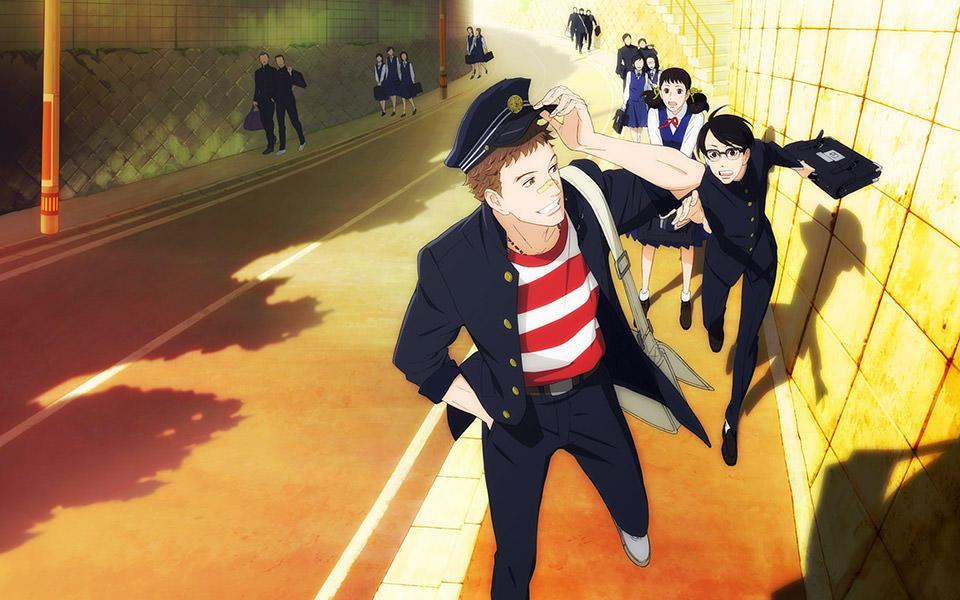Kids on the Slope by Shinichiro Watanabe (Review)

When I first described the plot of Kids on the Slope on an online forum, one of the other forum members joked “That doesn’t sound much like the anime I’ve seen. Is one of the students a demon-possessed cyborg who got stranded on Earth when his inter-dimensional spaceship was pulled through a wormhole by a malfunctioning dishwasher?” If you’ve ever spent any time watching anime, then you’ll know why that question was so funny: anime can be pretty weird, especially the stuff that makes it across the ocean. But what many Americans don’t realize is that anime is a very broad medium: it’s not all giant robots, buxom ladies with big guns, and angst-ridden teenage protagonists.
Indeed, there’s nothing anywhere near that flashy in Kids on the Slope… unless, that is, you consider a jazz showdown flashy. Yes, jazz. Because that’s really the heartbeat of Kids on the Slope, the love and influence of jazz as it affects friendships, love affairs, and other teenage melodrama.
Kaoru Nishimi has grown used to transferring from one school to the next, so much so that he feels no need to make friends. Not that he could if he wanted to, though: he’s so introverted that any significant amount of human interaction makes him nauseous. That all begins to change when he meets two students at his latest transfer. First is the pretty Ritsuko, on whom Kaoru instantly develops a major crush. The second is Sentarō, the school’s resident tough guy, a brash young man who is the complete and utter opposite of the quiet, refined Kaoru. However, when Sentarō learns that Kaoru is a talented pianist, he won’t leave him alone. Sentarō himself is a talented jazz drummer, and soon, shy Kaoru finds himself playing jazz with the unlikeliest of partners.
As with any sort of high school drama, animated or otherwise, Kids on the Slope has more than its fair share of melodrama, first love, romantic triangles, and did I mention melodrama? To its credit, the series — based on Yuki Kodama’s manga — uses those things to its advantage. I’m not usually one for high school melodrama, and yet I found myself consistently caught up in the various twists and turns, especially those related to Kaoru’s unrequited love for Ritsuko, and their relationship’s ups and downs. Also, while Sentarō could have easily been a one-note character with his swaggering to and fro, the series slowly reveals details that show him to be more than a fight-prone loudmouth.
However, if awkward high school romances and love triangles aren’t your thing, there’s the series’ lifeblood: jazz. The numerous musical sequences are a delight to watch, and not only because the music itself is fantastic. Shinichirō Watanabe — best known as the man behind Cowboy Bebop and Samurai Champloo — brings a considerable visual panache to Kaoru and Sentarō’s sessions. The animation for these scenes is impeccable, utilizing a technique not unlike Ralph Bakshi’s rotoscoping. Essentially, the characters are animated such that their actions are in time with the music they play. Such verisimilitude might seem like a trivial detail, yet it adds an undeniable energy to scenes like the one below.

Kids on the Slope isn’t perfect. It jumps around a lot, such that some of the character arcs don’t quite have the emotional heft that they’re clearly aiming for, and the series’ ending feels a little too neat and perfunctory for what it’s trying to accomplish. But those are minor quibbles because all in all, I thoroughly enjoyed this series. If nothing else, it reveals that anime can be so much more than recycled giant robot clichés. Or, to put it another way, Kids on the Slope may be unlike any anime you’ve ever seen precisely because it never tries to be unlike any anime you’ve ever seen. Rather, it just does it best to swing, baby, and that’s more than enough.
Kids on the Slope is currently streaming on Hulu and Crunchyroll.